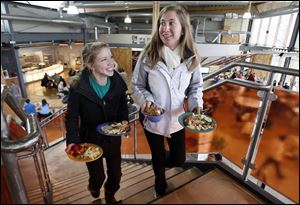
Trayless cafeterias at BGSU cut waste
Project part of effort to reduce, reuse, recycle
12/17/2012
Shannon Cassidy, left, and Amber Herron, both 19-year-old freshmen at BGSU, carry their food to a table at the Oaks dining hall. It and Carillon Place lack the cafeteria trays traditionally found in dining halls.
BOWLING GREEN — Cafeteria trays have carried food — and doubled as snow sleds — on university campuses for decades, but times they are a-changing at Bowling Green State University.
For the second year, students who eat at BGSU’s two newest dining facilities won’t find a tray in sight. Both the Oaks and Carillon Place are trayless — a concept intended to save water, energy, and cleaning chemicals and to keep students from loading up with more food than they can eat.
“Students naturally waste a lot of food because they eat with their eyes,” said Patrick Hannan, executive chef for BGSU Dining by Chartwells. “Some students think we’re trying to limit their consumption, but we’re not. We’d like you to sit, eat, taste, and make sure you want it first.”
Chartwells Higher Education Dining Services, which was hired to provide food service on campus in 2009, has gone trayless in recent years at dining halls from the University of New Mexico and Louisiana State to the University of Arkansas and Auburn.
Trays are still used in “a la carte” locations on campus like the food court at the Bowen Thompson Student Union. Both the Oaks and Carillon Place are “all-you-care-to-eat” facilities.
Nicholas Hennessy, sustainability coordinator at BGSU, said going trayless is all part of the university’s efforts to reduce, reuse, and recycle.
“If I had to choose between whether we have trays or 100 percent nondisposable items, I’d say if you can have both, even better,” Mr. Hennessy said. “At the Oaks and Carillon, we do. Everything is reusable.”
Sara Meyer, marketing director for BGSU Dining, said it’s difficult to measure the cost savings because both dining halls were trayless from day one. The university does measure food waste, though, in a twice-a-year effort called Project: Clean Plate.
During a specific week, patrons are encouraged to eat what they take and limit food waste. In October, overall food waste decreased by 375 pounds at the Oaks and 255 pounds at Carillon Place. At that rate, Ms. Meyer said, students could reduce food waste by 10 tons a year, “which is huge.”
The trayless trend reached the University of Toledo in 2008. Trays were removed from dining halls after Aramark took over food service operations. University spokesman Meghan Cunningham listed several reasons for eliminating the trays, among them the economic and environmental benefits of reducing water, energy, and cleaning detergents. The university also said there’s been less wasted food since trays were removed from cafeterias.
BGSU freshman Katie Jostes of Marysville, Ohio, said she usually makes multiple trips for food or tries “to pile it on one plate.”
“I think it’s a good idea,” she added. “It would cut down on water, but it is kind of inconvenient.”
Amber Herron said she doesn’t mind, though she said it’s best to get your food and go back for a drink.
“I’ve dropped stuff before,” the freshman from Columbus Grove said. “I had a plate on top of a bowl and it fell.”
Her friend, Shannon Cassidy of Ottawa, said the food is good and she doesn’t mind the extra exercise required by the trayless system.
“It makes sense and it’s not that inconvenient,” she said. “It’s five more steps to get another plate if you want it.”
Contact Jennifer Feehan at: jfeehan@theblade.com or 419-724-6129.